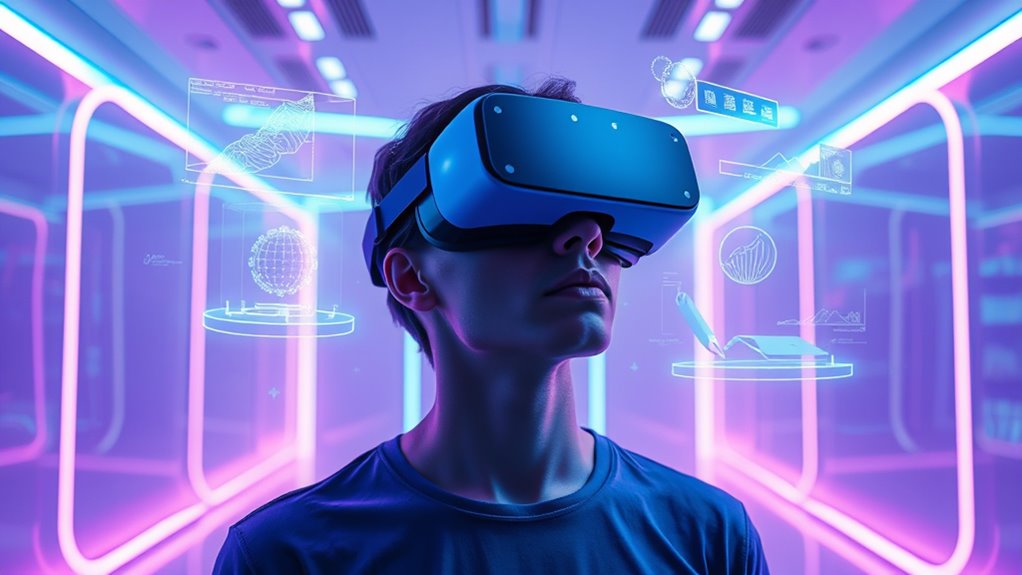The rise of virtual and augmented reality is changing how you interact with digital content by immersing you in realistic virtual worlds and seamlessly blending virtual elements into your real environment. These technologies are becoming more accessible, offering immersive experiences for gaming, training, education, and healthcare. As hardware improves and AI integration advances, VR and AR will become even more convincing and widespread. Keep exploring to discover how these innovations are shaping your future experiences.
Key Takeaways
- VR and AR technologies are becoming more affordable, user-friendly, and immersive, driving widespread adoption across industries.
- Advances in hardware and graphics have significantly enhanced the realism and engagement of virtual and augmented experiences.
- Both AR and VR are expanding into sectors like gaming, education, healthcare, and training, transforming traditional methods.
- Integration of AI and improved interaction tools are expanding AR and VR capabilities for smarter, personalized experiences.
- The growing investment and industry focus indicate a future where VR and AR will increasingly blend into everyday life and work.

Virtual reality (VR) creates a fully simulated environment that you can explore and interact with, often using headsets, data gloves, and motion controllers. When you put on a VR headset, you’re transported into a three-dimensional space that feels incredibly real, thanks to realistic visuals and spatial audio. This sense of presence makes VR ideal for gaming, training, education, and healthcare, where immersive experiences can improve learning, simulate complex scenarios, or aid recovery. Advances in graphics rendering and interactive tech keep making these experiences more convincing and engaging. Hardware improvements continue to enhance comfort and affordability, making VR accessible to more people. Additionally, the development of interactive technology further enhances the realism and engagement of VR experiences. As the technology evolves, visual fidelity is being significantly improved, providing even more immersive experiences.
VR immerses you in realistic 3D environments using headsets and controllers, enhancing gaming, training, and healthcare experiences.
AR’s ability to blend digital and real-world elements makes it popular for gaming, education, retail, and industrial applications. For instance, AR can give you real-time data during repairs or provide interactive educational content in a classroom. Its hardware continues to evolve rapidly, offering clearer visuals and more seamless interactions. The integration of AI-powered features is also expanding AR’s capabilities, enabling smarter overlays and more personalized experiences.
The main difference between VR and AR lies in their interaction with reality. VR creates a completely virtual world, while AR enhances your current environment with digital content. VR often requires specialized headsets and controllers, immersing you fully, whereas AR typically uses mobile devices or glasses, allowing you to remain aware of your surroundings. Both markets are growing rapidly as investments pour in, and their integration into various industries increases. You’re likely to see more of these technologies in everyday life, transforming how you learn, work, play, and connect.
The benefits of VR include heightened immersion, safer training simulations, and accessible experiences that might be physically impossible otherwise. Meanwhile, AR improves real-world interactions by providing instant information and enriching your environment without removing you from it. As both technologies advance, they promise to redefine how you perceive digital content and the world around you, making experiences more interactive, informative, and engaging.
Frequently Asked Questions
How Will Vr/Ar Impact Mental Health Long-Term?
You might wonder how VR/AR will affect mental health long-term. These technologies have the potential to improve empathy, reduce stigma, and enhance knowledge about mental illnesses.
They can provide immersive therapies for conditions like anxiety and PTSD. However, you should also consider risks like cybersickness and symptom worsening.
Ongoing research will clarify their lasting benefits and safety, helping you decide how best to incorporate them into mental health care.
What Are the Current Limitations of Vr/Ar Hardware?
Imagine donning a bulky headset that feels heavy and awkward on your head, blocking your view and causing discomfort. That’s the current reality of VR and AR hardware limitations.
You face high costs, processing demands, weight issues, and technical hurdles like latency and graphics quality. These factors make it tough for you to enjoy seamless, immersive experiences, especially when hardware isn’t accessible or scalable for widespread use.
How Accessible Is Vr/Ar Technology Worldwide?
You might find VR/AR technology varies widely in accessibility worldwide. While some regions see growing awareness and improved features, many still face barriers like limited infrastructure, high costs, and design gaps for disabilities.
You’ll notice that immersive experiences can be challenging for users with sensory or mobility impairments. To make VR/AR truly accessible, developers need to prioritize inclusive design and innovative solutions across global markets.
Will Vr/Ar Replace Traditional Education Methods?
Ever wonder if VR/AR will fully replace traditional education methods? It’s unlikely anytime soon. You’ll see hybrid models combining immersive tech with conventional teaching because VR improves retention and engagement, yet traditional methods still provide foundational knowledge.
While VR offers faster mastery and higher focus, barriers like costs and standardization prevent complete replacement. So, instead of one replacing the other, you’re more likely to see them work together for a richer learning experience.
What Are the Privacy Concerns With Vr/Ar Data Collection?
You should be aware that VR and AR collect sensitive data like biometric info, behavioral patterns, and location, raising privacy concerns.
This data can be stored insecurely, shared without your permission, or used for targeted ads and profiling.
Without proper safeguards, your conversations, emotions, and personal details might be exploited or misused.
It’s crucial to demand secure storage, clear consent, and strict regulations to protect your privacy in these immersive environments.
Conclusion
As you step into the domain of virtual and augmented reality, you hold the key to endless worlds—each a mirror reflecting possibility. These technologies are the gateway, the bridge between what is and what could be, like a compass guiding you through uncharted territories. Embrace this evolution, where reality blurs and imagination soars, for soon you’ll realize you’re not just a spectator but a creator in this vast digital landscape—your journey has only just begun.









